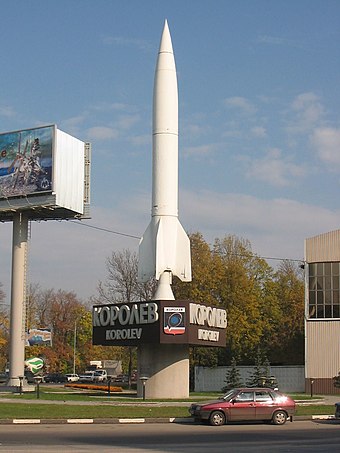R-2 (missile)
| R-2 | |
|---|---|
 R-2 missile at Korolev City of Moscow region | |
| Type | Theatre ballistic missile Short-range ballistic missile |
| Place of origin | USSR |
| Service history | |
| Used by | Soviet Union |
| Production history | |
| Manufacturer | Yuzhmash and OKB-1 |
| Specifications | |
| Mass | 19,632 kg |
| Length | 17.70 m |
| Diameter | 1.65 m |
| Wingspan | 3.60 m |
| Engine | RD-101 |
| Propellant | LOX / Alcohol |
Operational range | 600–1,200 km (370–750 mi)[1] |
| Maximum speed | 2175 m/s |
| Accuracy | 1.25 km |

The R-2 Short-range ballistic missile (NATO reporting name SS-2 Sibling, GRAU index 8Zh38) was developed based on the R-1 design. This was an improved version of the German V-2 rocket manufactured by the Soviet Union.
The R-1 was quickly followed by an evolutionary improvement, the R-2 (SS-2), which had a longer range and at least four major differences in design. The weight was increased by 50%, but the range was more than doubled, to 600 km (370 mi). R-2 had the following major differences from the R-1's (and hence from the V-2's) design:[2]
- The warhead separated from the rocket prior to atmospheric reentry, eliminating the hull strength problem, one of the V-2/R-1's biggest weaknesses.
- The propellant tank became the main load-bearing structure for the rocket, in contrast to the R-1's load-bearing hull. This reduced the overall weight of the spaceframe.
- The control module was moved from above the propellant tank to below the LOx tank. This made pre-launch preparations easier. As the control module was now placed directly over the engine, vibrations were reduced by using steel instead of aluminium for the tailcone.
- Radio command guidance was introduced to improve accuracy, giving the R-2 accuracy comparable to the R-1, in spite of its doubled range.
The first test flight of the R-2 took place in September 1949, and it was accepted for service in November 1951, actually entering service in large numbers around 1953. A grand total of 1,545 R-1 and R-2 missiles were produced.
The R-2 missile was the last Soviet missile based on German designs. While some German influences would clearly remain, Soviet missiles after the R-2 would be based on original designs by the OKB-1 group.
The R-2A geophysical rocket was developed for vertical sounding flights. It carried dogs, monkeys, hamsters, and various high-altitude physics experiments in its nose cone. Two pods performed atmospheric analysis and were ejected from the missile's side to avoid contamination by engine exhaust.
The R-2 design was exported to China, where it was built as the Dongfeng 1.
